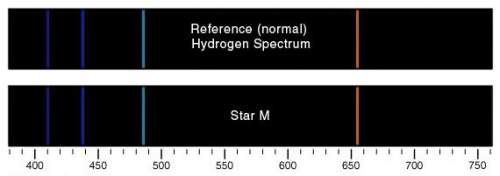
Physics, 29.11.2019 04:31 dorianhenderson987
1. the spectra of star m is compared to a reference hydrogen spectrum. what can be concluded about star m? select all that apply.
(picture below it's the first one! )
star m is showing radial motion
star m is moving toward the earth
star m is moving away from the earth
star m is not showing radial motion, but it may have transverse motion
2. the blackbody curve for a star named theta is shown below. the most intense radiation for this star occurs in what spectral band?
(picture below it's the second one! )
ultraviolet light
visible light
infrared radiation
radio waves
3. select all that apply.
the following diagram shows the path a planet around the sun. kepler discovered that
(picture below it's the third one! )
the distance from p3 to p4 is the same as the distance from p4 to p5
the speed from p3 to p4 is the same as the speed from p4 to p5
the area of b equals the area of c
the area of b does not equal the area of c





Answers: 1


Another question on Physics

Physics, 21.06.2019 23:30
After a big snowfall, you take your favorite rocket-powered sled out to a wide field. the field is 195 m across, and you know that your sled accelerates at a rate of 3.65 m/s2 when the rocket is on. how much time will it take the sled to cross the field starting from rest, assuming the rocket is on the whole time?
Answers: 1

Physics, 22.06.2019 02:00
Askydiver weighing 140 lb (including equipment) falls vertically downward from an altitude of 19,000 ft and opens the parachute after 18 s of free fall. assume that the force of air resistance, which is directed opposite to the velocity, is of magnitude 0.55|v| when the parachute is closed and is of magnitude 14|v| when the parachute is open, where the velocity v is measured in ft/s. assume that acceleration due to gravity has magnitude 32 ft/s/s; remember that weight is the product of mass and gravitational acceleration. (a) find the speed of the skydiver when the parachute opens. (b) find the distance fallen before the parachute opens. (c) what is the limiting velocity vl after the parachute opens? (d) determine how long the sky diver is in the air after the parachute opens. (e) plot the graph of velocity versus time from the beginning of the fall until the skydiver reaches the ground.
Answers: 1

Physics, 22.06.2019 14:40
An athlete is holding 24 lb of weights at a height of 6 inches above the stack as shown. to lower the weights, she applies a constant force of 5 lb to the handle. determine the velocity of the weights immediately before they hit the stack.
Answers: 1

Physics, 22.06.2019 17:30
Atruck driver is attempting to deliver some furniture. first, he travels 8 km east, and then he turns around and travels 3 km west. finally, he turns again and travels 13 km to his destination. what is the drivers total displacement?
Answers: 1
You know the right answer?
1. the spectra of star m is compared to a reference hydrogen spectrum. what can be concluded about s...
Questions

Physics, 15.12.2021 04:00

Engineering, 15.12.2021 04:00

Mathematics, 15.12.2021 04:00




Mathematics, 15.12.2021 04:00




Mathematics, 15.12.2021 04:00




Social Studies, 15.12.2021 04:00



Mathematics, 15.12.2021 04:00




